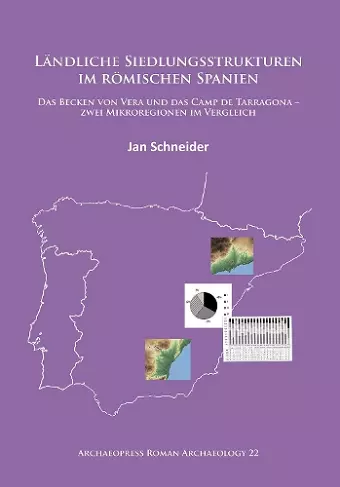Ländliche Siedlungsstrukturen im römischen Spanien
Das Becken von Vera und das Camp de Tarragona –zwei Mikroregionen im Vergleich
Format:Paperback
Publisher:Archaeopress
Published:13th Mar '17
Currently unavailable, our supplier has not provided us a restock date

The present study deals with the comparison of rural settlements, aiming to compare developments in various settlements of the Iberian Peninsula during the Roman era. This is to show to what extent structures in the hinterland show parallels or are different from one another and to explore the causes of these similarities and differences. Aspects of the Roman economy must be taken into account as well as the micro-regional influences of pre-Roman settlement or topographical conditions. To achieve this goal, various aspects of rural settlements such as the dating, size or status of a place and its location and environmental conditions are analyzed and related. Archaeological, geographic and statistical methods of investigation are used. These methods, along with the complete resulting data, are fully disclosed in order to allow the comparison to be extended to other regions. The Vera basin and the Camp de Tarragona were chosen as study areas. The former is located in the south-east of the Iberian Peninsula on the Spanish Mediterranean coast, and was seen in the Roman period as the hinterland of the city of Baria, today's Villaricos. Also on the Mediterranean coast of Spain, but in the north, is Camp de Tarragona. The name refers to the surrounding area of the Roman city of Tarraco, capital of the Hispania Tarraconensis province of the same name. German Description: Die vorliegende Untersuchung beschäftigt sich mit dem Vergleich ländlicher Siedlungsstrukturen. Ziel der Arbeit ist es, die Entwicklungen in verschiedenen Siedlungskammern der Iberischen Halbinsel während der römischen Epoche einander gegenüberzustellen. Dies soll zeigen, inwieweit Strukturen im Hinterland Parallelen aufweisen oder voneinander abweichen und worin die diese Gemeinsamkeiten und Unterschiede begründet sind. Dabei sind Aspekte des römischen Wirtschaftswesens ebenso zu berücksichtigen, wie mikroregionale Einflüsse der vorrömischen Besiedlung oder topographische Gegebenheiten. Um dieses Ziel zu erreichen, werden verschiedene Aspekte ländlicher Siedlungsstrukturen wie Datierung, Größe oder Status eines Platzes und dessen Standort- und Umgebungsbedingungen analysiert und in Beziehung zueinander gesetzt. Dabei kommen archäologische, geographische und statistische Untersuchungsmethoden zum Einsatz. Diese werden ebenso wie sämtliche Daten und Ergebnisse innerhalb der Arbeit vollständig offengelegt, um eine Ausweitung des Vergleichs auf weitere Regionen zu ermöglichen. Als Untersuchungsgebiete wurden das Becken von Vera und das Camp de Tarragona ausgewählt. Ersteres liegt im Südosten der Iberischen Halbinsel an der spanischen Mittelmeerküste...
ISBN: 9781784915544
Dimensions: 290mm x 205mm x 10mm
Weight: 820g
226 pages